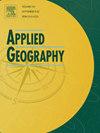儿童从家到学校路线中绿化覆盖率与步行距离权衡的城市异质性
IF 4
2区 地球科学
Q1 GEOGRAPHY
引用次数: 0
摘要
绿化可营造可持续的户外环境,促进步行和健康的生活方式。绿化儿童从家到学校的路线可被视为一种环境可持续发展的解决方案,能增强他们与大自然的日常互动。然而,城市中的绿化和路线网络分布不均,导致包括儿童在内的行人体验绿化的机会各不相同。我们重点研究了城市中所有儿童从家到学校的最短和最绿的假定路线。为此,我们以罗兹(波兰)为案例城市,利用小学生、步行街网络和高分辨率城市绿地地图等多个空间明确数据集进行了空间分析。然而,要最大限度地接触绿色植物,需要选择比最短路线长 9.5%(46 米)的路线。与其他城市区域相比,城市核心区域的儿童在最短和最绿的家校路线之间的权衡更为明显。在分配新绿地以支持主动交通时,应考虑这种城市异质性。本文章由计算机程序翻译,如有差异,请以英文原文为准。
Urban heterogeneity of the trade-offs between exposure to greenery and walking distance in children's home–school routes
Greenery fosters sustainable outdoor environments and promotes walking and healthy lifestyles. Greening children's home–school routes can be seen as an environmentally sustainable solution that enhances their daily interaction with nature. However, the uneven distribution of greenery and route networks within cities results in varied opportunities for pedestrians, including children, to experience greenery.
This study evaluates the urban heterogeneity of trade-offs between exposure to greenery and route length. We focus on the shortest and greenest hypothetical home–school routes for all children in the city. For this purpose, we conducted a spatial analysis using multiple spatially explicit data sets on primary schoolchildren, pedestrian street networks, and high-resolution urban green space maps, with Łódź (Poland) as the case study city.
Children who opt for the greenest hypothetical routes instead of the shortest could increase their exposure to greenery by 18%. However, maximizing exposure to greenery requires choosing routes 9.5% (46 m) longer than the shortest alternative. The trade-off between the shortest and greenest home–school routes is more pronounced for children in the urban core area compared to other city zones. This urban heterogeneity should be considered when allocating new greenery to support active transportation.
求助全文
通过发布文献求助,成功后即可免费获取论文全文。
去求助
来源期刊

Applied Geography
GEOGRAPHY-
CiteScore
8.00
自引率
2.00%
发文量
134
期刊介绍:
Applied Geography is a journal devoted to the publication of research which utilizes geographic approaches (human, physical, nature-society and GIScience) to resolve human problems that have a spatial dimension. These problems may be related to the assessment, management and allocation of the world physical and/or human resources. The underlying rationale of the journal is that only through a clear understanding of the relevant societal, physical, and coupled natural-humans systems can we resolve such problems. Papers are invited on any theme involving the application of geographical theory and methodology in the resolution of human problems.
 求助内容:
求助内容: 应助结果提醒方式:
应助结果提醒方式:


